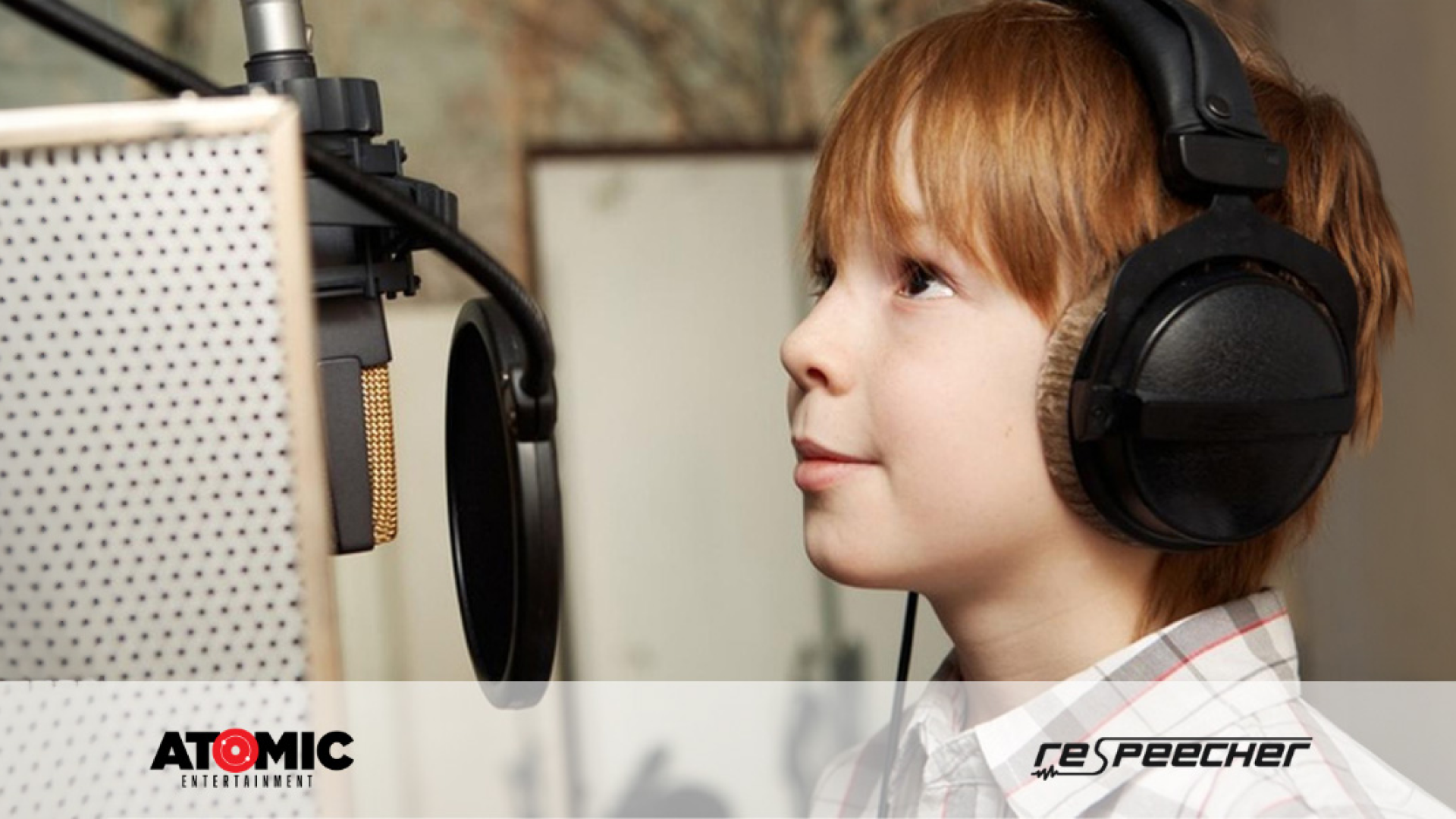
AI Voice Cloning Enhances Child Voice Reproduction for Educational Content
Child actors make movies unique. However, filming and recording children can be difficult, especially with regard to speech and dialog for multiple scenes.
Our recent client, Atomic Entertainment, is an Emmy award-winning production company that creates and produces fun, information-driven shows for children and their families. Since the content they produce is children-specific podcasts and videos, they often require recordings of children's voices. After years of experience working with children, Atomic was looking to alleviate the different challenges they were facing while filming and recording children for their programs. That’s when the company turned to Respeecher.
"We’ve been aware of voice cloning for the past few years from press and media articles. We learned about Respeecher in particular while researching solutions for some of our projects", says Jerry Kolber, CEO of Atomic Entertainment. The company found Respeecher's technology to be advanced and able to satisfy the needs of its project.
The Challenge
Sound engineers face a variety of challenges when filming and recording a child’s speech, the most common include:
- As a child grows up, their voice changes. If the situation arises where a re-recording becomes necessary, the young actor's voice may not be the same as when it was recorded.
- Acting skills. Young stars who excel on set often fail to get into character while in the studio.
- Scheduling. Children attend kindergartens or schools and can't be expected to devote the number of hours to a project that an adult can. For Atomic Entertainment, this was the biggest challenge.
"We work with many child actors for whom scheduling and availability can be an issue, particularly with the demanding logistics of our fast-paced publishing schedule," explains Kolber.
The Solution
With Speech-to-speech technology, children don't have to be present in the studio for hours on end. You need only record one hour of a child actor's voice, and an adult actor can then read the required dialog. Using this hour-long recording, any voice can be synthesized into the child's while retaining all the shades of emotion, accent, and speech characteristics.
Instead of a child, a professional dubbing actor can dub different scenes, thereby saving the nerves of parents, children, and the entire production team.
"We appreciate the fact that Respeecher's voice cloning still requires a human actor to record the material, allowing us to transpose voices without reducing the aggregate working hours of human actors," notes Kolber.
The Result
Atomic Entertainment brought in Respeecher as a productive tool for high-volume audio productions. With the help of our platform, the company was able to reduce the complexity of the process of reproducing children’s voices while adding flexibility to the entire operation.
At the same time, Atomic Entertainment focused on preserving the role of voice actors while creating content.
"We are a very human-centric organization that uses technology and AI to support and expand our ability to have the greatest educational impact on the biggest addressable market. It was important to us that any voice cloning technology we adapted would not eliminate or reduce the need for human actors. One concern would be a situation where human actors were no longer necessary — we'd consider that a real loss," explains Kolber.
The Atomic Entertainment team was pleased that their collaboration with Respeecher allowed them to involve human actors and leverage their voices for smoother content production.
 The client was also concerned about the security of the source voices, which was addressed immediately as Respeecher sticks to a strict code of ethics regarding the use of individual voices.
The client was also concerned about the security of the source voices, which was addressed immediately as Respeecher sticks to a strict code of ethics regarding the use of individual voices.
Our collaboration with Atomic Entertainment proves that if you need children's voices for your project — it's better to reproduce them using AI. You will save your time and the time of the little actors while eliminating production headaches and hassle.
FAQ
AI voice cloning creates artificial copies of people's voices, including child voice reproduction. This technology analyzes the unique qualities of a person’s speech, allowing the creation of synthetic child voices that replicate the original’s sound, rhythm and emotion. It then generates AI-generated children's speech that sounds just like the original.
Speech synthesis technology, such as AI voice cloning, benefits educational content by providing consistent and diverse voiceovers without needing the original voice actor present. It saves time, reduces scheduling conflicts, and allows content creators to produce more engaging and flexible learning materials, enhancing the educational experience.
Child voice reproduction with AI tackles issues like voice changes over time, scheduling difficulties, and maintaining consistency in voice performance. It enables seamless re-recordings and ensures that educational content remains coherent, even if the child actor is unavailable or their voice has altered since the initial recording.
Respeecher stick to a strict code of ethics when using AI-generated voices. It ensures the security of the original voice data and obtains consent from voice actors. By using AI responsibly, it protects the rights of individuals while offering innovative solutions for educational content creation.
Yes, AI-generated child voices can be customized to suit various educational themes. Using AI voice cloning technology, creators can adjust the tone, emotion and speech patterns to match different contexts, such as storytelling, interactive learning or character-based content, making educational materials more engaging for young audiences.
Glossary
Speech synthesis technology
Child voice reproduction
Educational content creation
Respeecher voice technology
AI Voice Cloning
in Child voice reproduction
Respeecher's high-end AI voice cloning technology lets children's voices be recreated for educational content production, saving time in terms of scheduling, acting, and consistency. It improves educational content and voiceovers with the least possible disturbance.
-
Overcoming Classic Problems
in Child Voice RecordingCreating high-quality educational content creation for children comes with unique challenges, particularly the evolution of a child’s voice. If re-recording is needed, it may not match the original voice. Respeecher voice technology offers a solution through AI voice cloning and synthetic child voices, making accurate child voice reproduction without the need for re-recording. By using speech synthesis technology and AI-generated children’s speech, voice cloning for education becomes faster and more flexible. These innovations streamline production, enhancing learning with AI voices and overcoming logistical obstacles. With child voiceover solutions, content creators can maintain consistency and meet tight deadlines without sacrificing quality.
-
Revolutionizing Child Voiceover
Production with Speech Synthesis
TechnologyTo address such concerns, Respeecher introduced its AI voice cloning technology to the workflow of Atomic Entertainment. Advanced speech synthesis technology from Respeecher replicates a child's voice from just one recorded hour of audio. This lets adult actors step in and record the necessary dialogue while preserving the child's unique voice characteristics: pitch, cadence, and emotion.
By following such a novel approach, it will reduce a lot of time and remove much of the stress associated with child actor availability, while simultaneously keeping the voice consistent throughout episodes or scenes. Moreover, the resultant AI-generated voice retains all nuances from the original speech of that child, thereby fitting perfectly with creating educational contents.
This way, Respeecher's voice technology for education ensures that content producers like Atomic Entertainment can meet their publishing deadlines without compromising the authenticity and quality of the material.
-
Enhanced Flexibility and Time Savings
for Educational Content ProductionAtomic Entertainment applied Respeecher's voice cloning technology to make their production processes more efficient for their children's content. That helped the team overcome some major scheduling issues and save time during production, as now it was possible to use AI-generated synthetic child voices for different educational themes.
Of critical importance, technology by Respeecher also facilitates the involvement of human voice artists; it ensures the role of artificial intelligence complements, rather than replaces, theirs. This atomic approach is one that Atomic Entertainment holds dear-towards human-centered, high quality educational content.
However, Atomic Entertainment most importantly prioritized the ethical AI voice cloning technology: Respeecher followed a specific code of conduct regarding the use and security of source voices while interacting with Atomic for the first time, assuring them that Atomic's intellectual properties and voice-related data would receive care comparable to that from the most reputed companies.
-
Why AI-Generated Child Voices
Are Transforming Educational
Content CreationRespeecher voice technology is a game-changer for the educational content industry. By leveraging AI to reproduce child voices, content creators are able to enhance learning experiences while addressing traditional challenges in voiceover production. Whether it’s ensuring consistency across episodes or overcoming logistical challenges, AI voice cloning for education has made the process more efficient and flexible.
With AI-generated children's speech, creators can produce engaging, consistent, and compelling educational material that speaks to young audiences. This forward-thinking solution has opened up new possibilities for content creators who want to maximize the impact of their work while minimizing production headaches. Respeecher's technology proves that when it comes to educational voiceovers, synthetic child voices are not just a convenience—they are an innovation that enhances the learning experience.







